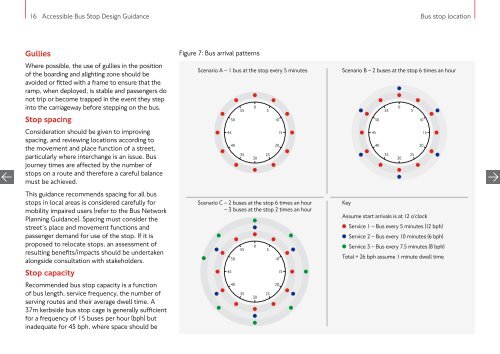ACCESSIBLE BUS STOP DESIGN GUIDANCE
bus-stop-design-guidance
bus-stop-design-guidance
You also want an ePaper? Increase the reach of your titles
YUMPU automatically turns print PDFs into web optimized ePapers that Google loves.
16 Accessible Bus Stop Design Guidance<br />
Bus stop location<br />
Gullies<br />
Where possible, the use of gullies in the position<br />
of the boarding and alighting zone should be<br />
avoided or fitted with a frame to ensure that the<br />
ramp, when deployed, is stable and passengers do<br />
not trip or become trapped in the event they step<br />
into the carriageway before stepping on the bus.<br />
Stop spacing<br />
Consideration should be given to improving<br />
spacing, and reviewing locations according to<br />
the movement and place function of a street,<br />
particularly where interchange is an issue. Bus<br />
journey times are affected by the number of<br />
stops on a route and therefore a careful balance<br />
must be achieved.<br />
This guidance recommends spacing for all bus<br />
stops in local areas is considered carefully for<br />
mobility impaired users (refer to the Bus Network<br />
Planning Guidance). Spacing must consider the<br />
street’s place and movement functions and<br />
passenger demand for use of the stop. If it is<br />
proposed to relocate stops, an assessment of<br />
resulting benefits/impacts should be undertaken<br />
alongside consultation with stakeholders.<br />
Stop capacity<br />
Recommended bus stop capacity is a function<br />
of bus length, service frequency, the number of<br />
serving routes and their average dwell time. A<br />
37m kerbside bus stop cage is generally sufficient<br />
for a frequency of 15 buses per hour (bph) but<br />
inadequate for 45 bph, where space should be<br />
Figure 7: Bus arrival patterns<br />
Scenario A – 1 bus at the stop every 5 minutes<br />
45<br />
50<br />
40<br />
55<br />
35<br />
0<br />
30<br />
Scenario C – 2 buses at the stop 6 times an hour<br />
– 3 buses at the stop 2 times an hour<br />
45<br />
50<br />
40<br />
55<br />
35<br />
0<br />
30<br />
5<br />
25<br />
5<br />
25<br />
10<br />
20<br />
10<br />
20<br />
15<br />
15<br />
Scenario B – 2 buses at the stop 6 times an hour<br />
0<br />
55<br />
5<br />
50<br />
45<br />
40<br />
10<br />
15<br />
20<br />
35<br />
30<br />
25<br />
Key<br />
Assume start arrivals is at 12 o’clock<br />
Service 1 – Bus every 5 minutes (12 bph)<br />
Service 2 – Bus every 10 minutes (6 bph)<br />
Service 3 – Bus every 7.5 minutes (8 bph)<br />
Total = 26 bph assume 1 minute dwell time



